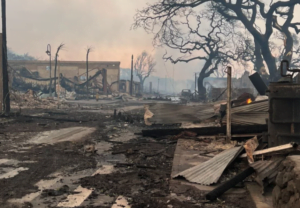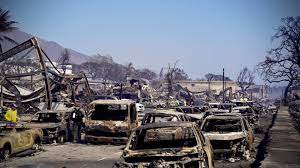Reading time: 3 minutes.
The picturesque island of Maui has been thrust into a state of emergency as Maui fires rage through its lands, prompting widespread evacuations, road closures, and shelter updates. The fires, fueled by the dry winds of a passing hurricane, have caused devastation across Lahaina town, Kula, and the Upcountry areas. Local officials, along with state and federal resources, are working tirelessly to combat the flames and ensure the safety of residents and visitors alike.

Unprecedented Disaster: The Call for Evacuations
As the flames engulfed large swathes of Maui Fire, Lt. Gov. Sylvia Luke, acting as governor in the absence of Gov. Josh Green, declared a state of emergency. This declaration marked the gravity of the situation, with Luke referring to the event as “an unprecedented disaster.” The urgency of the moment led to swift actions, including multiple evacuations and the activation of the Maui County Emergency Operating Center.
A Night of Shelter and Support
More than 2,100 individuals sought refuge in emergency shelters as the fires raged on. The War Memorial Complex extended its hours to provide a donation drop-off center for evacuees, collecting essential items such as non-perishable food, bottled water, hygiene products, and blankets. The community’s response highlighted the solidarity and resilience of Maui’s inhabitants.
Facing the Fury: Battling the Blaze
Maui County officials collaborated with the state Emergency Management Agency to secure resources from both state and federal levels. Despite the challenging circumstances, Kahului Airport remained operational, allowing outgoing flights. However, visitors were strongly advised against traveling to areas affected by the wildfires to ensure their safety.
The Aftermath: Assessing the Damage
The Maui fires left behind a trail of destruction, particularly impacting Lahaina town. Prompted by safety concerns, officials urgently requested that visitors possessing transportation leave the affected area. Unfortunately, the flames also disrupted communication systems, rendering both landlines and cellphone services unavailable in Lahaina.
Nature’s Wrath Continues: Weather Conditions
The fierce, dry winds from Hurricane Dora contributed to the rapid spread of the Maui fires. National Weather Service officials warned that these conditions would persist through the night, maintaining “dangerous fire weather conditions.” Nevertheless, a more hopeful outlook was anticipated as the hurricane’s trajectory shifted away from the islands, hinting at a return to more normal weather patterns.
Navigating Chaos: Evacuations, Closures, and Shelters
The authorities orchestrated mass evacuations to ensure the safety of residents and visitors. A significant effort was made to relocate individuals from areas at risk. Notably, the Maui County fire officials recommended proactive evacuations for several neighborhoods, including Kula, Holopuni, Pulehi roads, Lahainaluna Road, Hale Mahaolu, Kelawea Mauka, Lahaina Bypass, Piʻiholo, Olinda roads, Kulalani Drive, Kulalani Circle subdivision, Kula 200, and Hanamu Road areas.
Shelters of Hope Amidst the Flames
Emergency shelters were established to provide refuge for those displaced by the fires. However, it’s essential to note that these shelters may not have essential items like bedding and toiletries readily available. Pet owners were urged to ensure their animals’ safety during this challenging time. The shelters included Maui High School, Hannibal Tavares Community Center, War Memorial Complex, and Oskie Rice Arena (for farm and ranch animals only).
Roadblocks and Disruptions: Maui’s Closed Roads
The Maui fires also necessitated road closures across the island. These closures aimed to safeguard both residents and emergency responders. Notable road closures included all roads in Lahaina town, Kealaloa Avenue, Haleakala Highway at Lower Kimo Road, and Haleakala Highway at Kula Highway.
Service Disruptions: Impact on Education and Transportation
The Maui fires had far-reaching effects, resulting in the closure of all Maui public schools and Boys & Girls Clubs of Maui Clubhouses. The Maui Bus services, including various routes and ADA Paratransit Service, were also temporarily suspended. These service disruptions showcased the extent of the Maui fires’ impact on daily life.
Conclusion: Responding to Adversity
Maui finds itself in the throes of a challenging situation, as wildfires driven by hurricane winds wreak havoc across its picturesque landscape. The collective response of the community, officials, and emergency services reflects the determination to overcome adversity and safeguard lives. As the Maui fires continue to be battled and the situation evolves, the people of Maui stand united in their resolve to recover and rebuild.
Frequently Asked Questions about Hawaii Fires(Maui Fire)
1. How did the wildfires in Maui start? The exact cause of the wildfires is still under investigation. However, the dry winds from Hurricane Dora played a significant role in their rapid spread.
2. Are the evacuation shelters adequately equipped? While the evacuation shelters provide a safe haven, they may not have items like bedding and toiletries readily available. Pet owners should also ensure the safety of their animals.
3. How can I help those affected by the fires? Consider donating non-perishable food, bottled water, hygiene products, and blankets to the designated donation drop-off centers.
4. Are there any resources for locating missing individuals? If you’re searching for a loved one, you can call the American Red Cross hotline at 1-800-733-2767 for assistance.
5. What is the outlook for weather conditions in the coming days? Officials anticipate a return to more normal trade wind patterns as Hurricane Dora moves away from Hawaii, potentially bringing relief from the current dangerous fire weather conditions.




